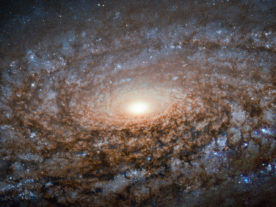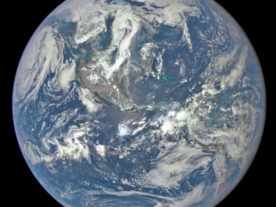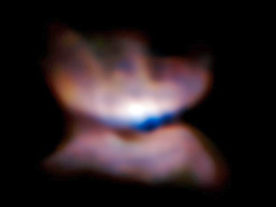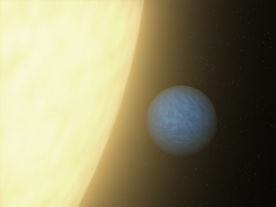
September 2015 Science Images
Whirling Black Holes’ Dance to End in Cosmic Blast
Some 3.5 billion light years from Earth, in the Virgo Constellation, there are two black holes (binary black hole), locked by gravity, that are madly orbiting each other. But their orbits are continuing to close in and scientists from Columbia University expect that in about 100,000 years they will join together in one huge cosmic […]

Astronomers Find Massive Star Making Galaxy Cluster
Astronomers have discovered a distant and massive galaxy cluster with a gigantic and prolific galaxy at its heart that’s pumping out hundreds of stars each year. The galaxy cluster is named SpARCS 1049+56 and is located about 9.8 billion light years from Earth in the Ursa Major constellation. Galaxy clusters are areas of the universe […]

Bed-In for Science; Microbes Abound in House Dust ; Twin Black Holes Power Quasar
ESA Experiment Will Send a Dozen Men to Bed for 60 Days How would you like to spend the next 60 days in bed? That’s what the European Space Agency is asking 12 men to do, all in the name of science. The first members of this group of a dozen will hit the sack […]

July 2015 Science Images

Astronomers Image Birth of a Planetary Nebula in Sharp Detail
For the first time ever, a team of astronomers have captured stunning pictures of one of the universe’s most impressive sights: the birth of a bipolar ‘planetary nebula.’ The scientists gathered the images of nebula surrounding L2 Puppis using the European Southern Observatory’s (ESO) Very Large Telescope or VLT, in the Atacama Desert of northern […]
Pluto Moons Dance in Chaotic Orbit
Pluto and its moons seem to be engaged in a kind of chaotic dance routine with each other. After a thorough analysis of data gathered by the Hubble Space Telescope, NASA scientists found that Nix and Hydra – two of Pluto’s five known moons – are wobbling and behaving erratically as they orbit the distant […]

Science Scanner: Sea Salt on Europa; Natural Sunblock; ISS Crew Return Delayed
Sea Salt Covers Parts of Europa’s Surface Scientists at NASA’s Jet Propulsion Laboratory found evidence that the dark material that covers parts of the surface of Jupiter’s moon Europa is probably sea salt produced by an ocean beneath its surface. The researchers believe that the existence of sea salt on the moon’s icy surface implies […]

Astronomers Detect a Galaxy Far, Far Away
Astronomers have discovered the most distant galaxy ever detected, gaining new insight into the early beginnings of our universe. Identified as EGS-zs8-1, the international team of astronomers measured its exact distance at 13 billion light years away from Earth. That means that light from the galaxy now reaching Earth was produced back when the universe […]

Astronomers Observe Exoplanet Temperatures Swinging Wildly
For the first time ever, scientists in the United Kingdom detected temperature fluctuations on a super-Earth exoplanet – 55 Cancri e, the so-called “diamond planet.” Using NASA’s Spitzer Space Telescope to study the rocky exoplanet’s thermal radiation over a two-year period, researchers led by the University of Cambridge found that the temperature on the side […]
